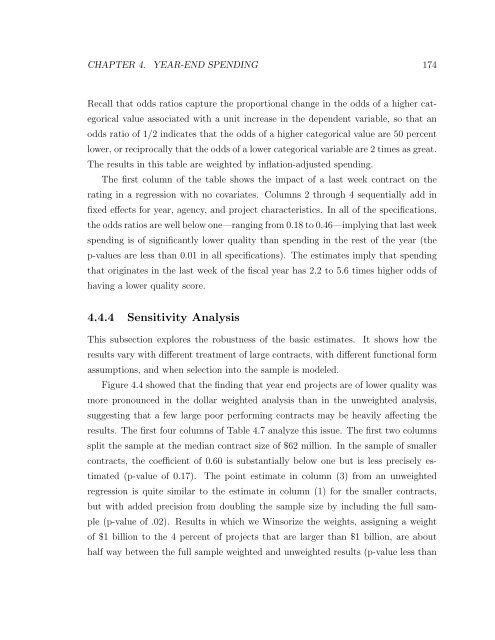essays in public finance and industrial organization a dissertation ...
essays in public finance and industrial organization a dissertation ...
essays in public finance and industrial organization a dissertation ...
Create successful ePaper yourself
Turn your PDF publications into a flip-book with our unique Google optimized e-Paper software.
CHAPTER 4. YEAR-END SPENDING 174<br />
Recall that odds ratios capture the proportional change <strong>in</strong> the odds of a higher cat-<br />
egorical value associated with a unit <strong>in</strong>crease <strong>in</strong> the dependent variable, so that an<br />
odds ratio of 1/2 <strong>in</strong>dicates that the odds of a higher categorical value are 50 percent<br />
lower, or reciprocally that the odds of a lower categorical variable are 2 times as great.<br />
The results <strong>in</strong> this table are weighted by <strong>in</strong>flation-adjusted spend<strong>in</strong>g.<br />
The first column of the table shows the impact of a last week contract on the<br />
rat<strong>in</strong>g <strong>in</strong> a regression with no covariates. Columns 2 through 4 sequentially add <strong>in</strong><br />
fixed effects for year, agency, <strong>and</strong> project characteristics. In all of the specifications,<br />
the odds ratios are well below one—rang<strong>in</strong>g from 0.18 to 0.46—imply<strong>in</strong>g that last week<br />
spend<strong>in</strong>g is of significantly lower quality than spend<strong>in</strong>g <strong>in</strong> the rest of the year (the<br />
p-values are less than 0.01 <strong>in</strong> all specifications). The estimates imply that spend<strong>in</strong>g<br />
that orig<strong>in</strong>ates <strong>in</strong> the last week of the fiscal year has 2.2 to 5.6 times higher odds of<br />
hav<strong>in</strong>g a lower quality score.<br />
4.4.4 Sensitivity Analysis<br />
This subsection explores the robustness of the basic estimates. It shows how the<br />
results vary with different treatment of large contracts, with different functional form<br />
assumptions, <strong>and</strong> when selection <strong>in</strong>to the sample is modeled.<br />
Figure 4.4 showed that the f<strong>in</strong>d<strong>in</strong>g that year end projects are of lower quality was<br />
more pronounced <strong>in</strong> the dollar weighted analysis than <strong>in</strong> the unweighted analysis,<br />
suggest<strong>in</strong>g that a few large poor perform<strong>in</strong>g contracts may be heavily affect<strong>in</strong>g the<br />
results. The first four columns of Table 4.7 analyze this issue. The first two columns<br />
split the sample at the median contract size of $62 million. In the sample of smaller<br />
contracts, the coefficient of 0.60 is substantially below one but is less precisely es-<br />
timated (p-value of 0.17). The po<strong>in</strong>t estimate <strong>in</strong> column (3) from an unweighted<br />
regression is quite similar to the estimate <strong>in</strong> column (1) for the smaller contracts,<br />
but with added precision from doubl<strong>in</strong>g the sample size by <strong>in</strong>clud<strong>in</strong>g the full sam-<br />
ple (p-value of .02). Results <strong>in</strong> which we W<strong>in</strong>sorize the weights, assign<strong>in</strong>g a weight<br />
of $1 billion to the 4 percent of projects that are larger than $1 billion, are about<br />
half way between the full sample weighted <strong>and</strong> unweighted results (p-value less than










